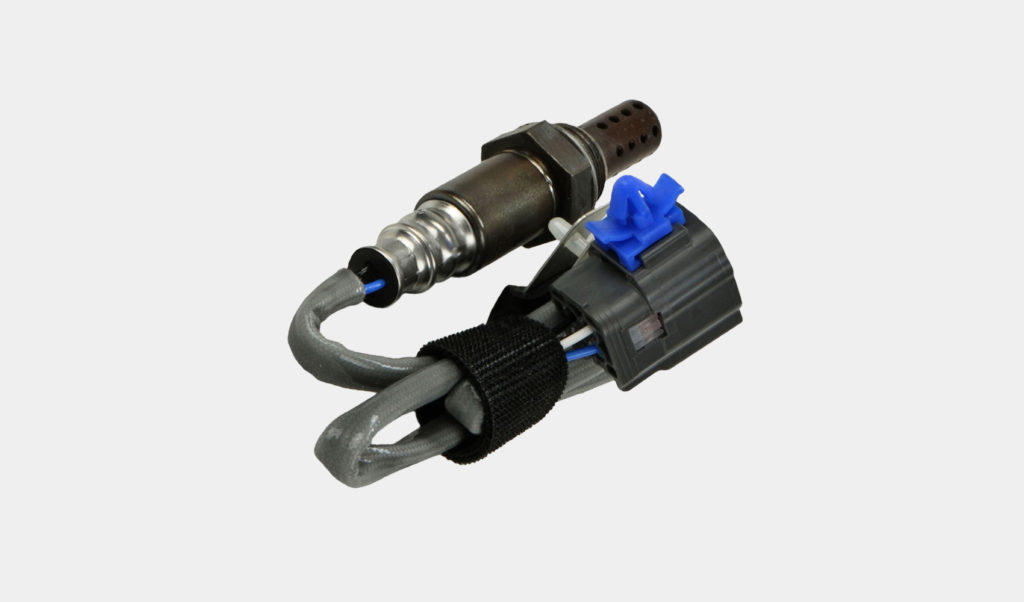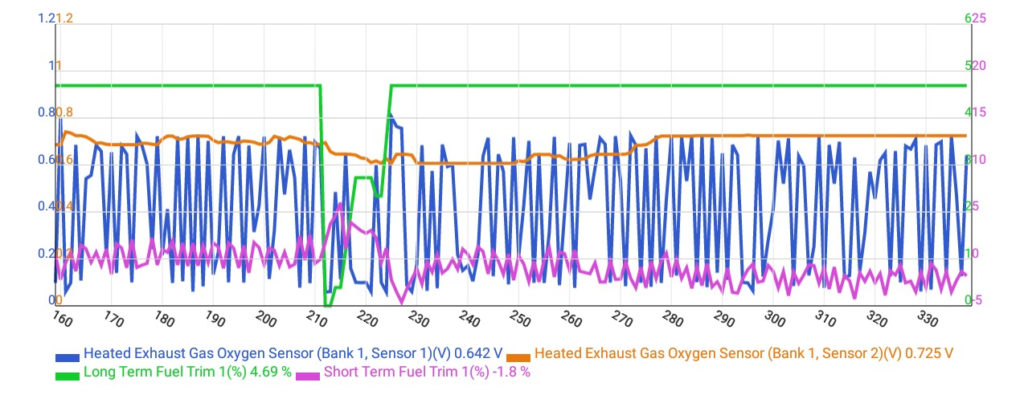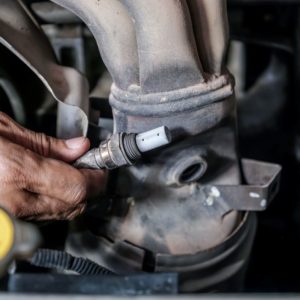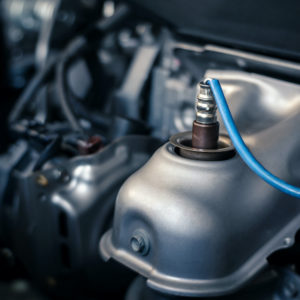Oxygen sensors measure how much oxygen remains in the exhaust gases expelled by the engine into the exhaust system. Their readings are sent to the powertrain control module (PCM), which uses the data to adjust the amount of fuel sprayed into the engine.
If the PCM notices that the voltage signals from an oxygen sensor are not shifting as they should, its diagnostics will log a P2272 code.
What Does the P2272 Code Mean?
The Diagnostic Trouble Code (DTC) P2272 indicates “Oxygen Sensor Signal Biased/Stuck Lean (Bank 2 Sensor 2).”
Oxygen sensors emit a voltage signal that changes according to the amount of oxygen in the engine’s exhaust gases. Rich exhaust with low oxygen levels causes the voltage to rise as high as 1,000 millivolts (mV). Conversely, lean exhaust rich in air lowers the voltage to a minimum of 10 mV. At least 10 of these voltage signals are emitted every second.

The PCM provides a baseline voltage of 450 mV, roughly in the middle of the oxygen sensor’s high and low signal circuits. It also takes samples of the sensors’ voltage signals and compares them to the information stored in its memory. The computer checks how long the voltage stays out of the correct range and counts how many samples go too far.
If most of the voltage samples are much lower than the expected operating range, the PCM will set the powertrain code P2272.
For more technical information that can help you better understand P2272, especially if you’re planning to diagnose or fix it yourself, read our note about O2 sensors, rich / lean conditions, and fuel trims.
Note: The definition of code P2272 may differ according to the vehicle manufacturer. Check the appropriate repair manual or repair database for the exact code definition.
What are the Common Causes of the P2272 Code?
- A faulty sensor (oxygen sensor, mass airflow sensor, etc.)
- Vacuum leak
- Fuel delivery issues
- Exhaust leak
- Issue with the PCM, such as software in need of an update

What are the Common Symptoms of the P2272 Code?
- Illuminated check engine light
- Engine performs poorly
- Higher fuel consumption
How to Diagnose the P2272 Code
A DTC P2188 is a generic powertrain code that may be logged in vehicles from different auto manufacturers. Vehicles can share apparently similar triggers and symptoms. However, the steps for diagnosis and repair can differ between various makes and models.
If you’re not confident about conducting diagnostic tests on your vehicle, it’s a good idea to bring it to a professional mechanic. Otherwise, you may go ahead and diagnose the issue yourself. To help you get started, here is a video that may give you an idea of what the process might involve:
How to Fix the P2272 Code
Attempting to fix a P2272 code may become a frustrating task if you don’t have the right tools and know-how to test the oxygen sensor. In most cases, it’s best to leave the job to professionals.
For DIYers with advanced technical knowledge and hands-on experience who prefer to do the job on their own, it will be helpful to rely on the appropriate repair manual or refer to an online repair database.
A Note About O2 Sensors, Rich / Lean Conditions, and Fuel Trims
O2 sensors detect oxygen, not fuel, so a misfiring cylinder will send unburned fuel and air through the exhaust, but all the O2 sensor will detect is the oxygen. It has no way to detect hydrocarbons or nitrogen. That being said, the O2 sensor’s input to the PCM will drive the fuel trims in the direction of adding more fuel due to the perceived lean condition. And it happens very rapidly.
“Lean” means an imbalance that the O2 sensor perceives as out of balance, with 14.7:1 being the target. That’s 14.7 parts air (by weight) to 1 part fuel (by weight), which is how engineers measure fuel and air in this context. By volume, an engine uses 9,000 gallons of air for every one gallon of fuel.
Conventional O2 sensors switch back and forth above and below .45-.50 volts, with voltages higher than the .45-.50 volt threshold indicating rich (too little air) and voltage below the .45-.50 volt threshold indicating lean (too much air).

The green trace is long term fuel trim (LTFT) and the purple trace is short term fuel trim (STFT). Notice how rapidly STFT reacts to the O2 sensor’s switching. Long term fuel trim will typically only react rapidly in response to changing load conditions or rapid throttle response.
The yellow trace in the screen print is the downstream O2 sensor behind the warmup catalyst on bank 1. Notice how lazy that sensor is compared to the upstream sensor.
What most mechanics don’t even know is that the downstream sensor will become the primary input for closed loop fuel calculations if the PCM/ECM detects that the upstream O2 sensor becomes biased. And a code will be stored. | Source: Richard McCuistian
Any information provided on this Website is for informational purposes only and is not intended to replace consultation with a professional mechanic. The accuracy and timeliness of the information may change from the time of publication.















